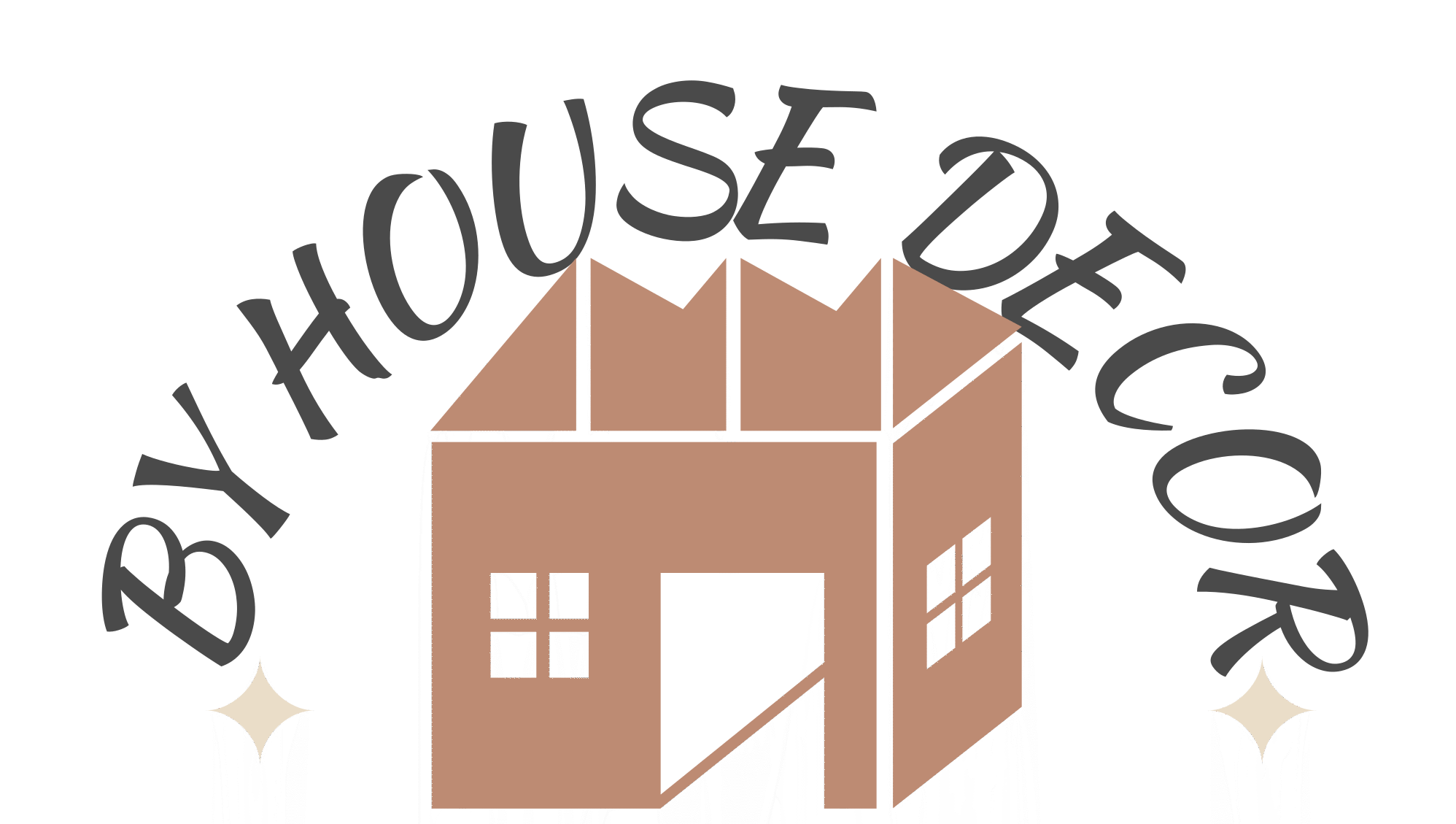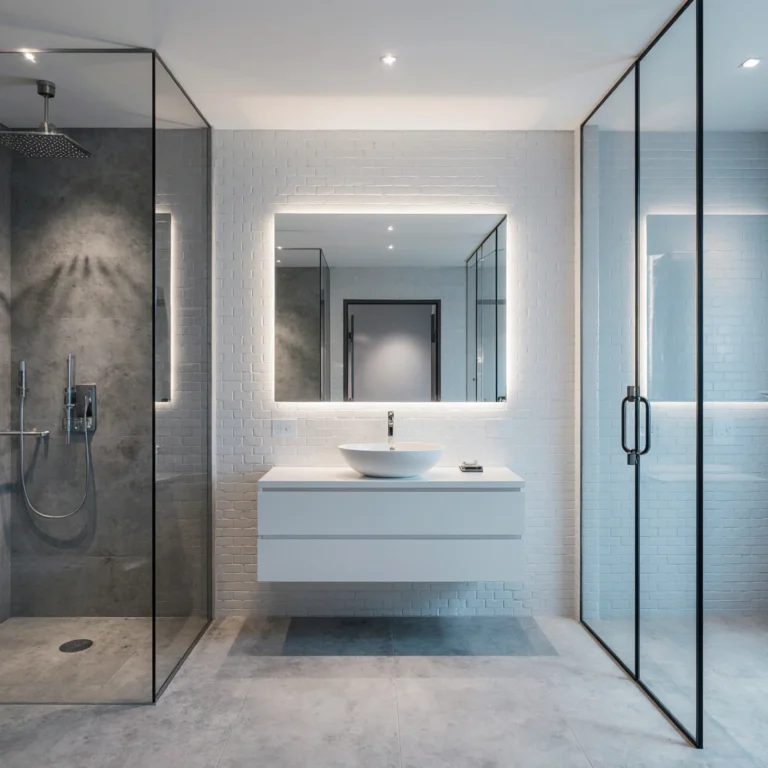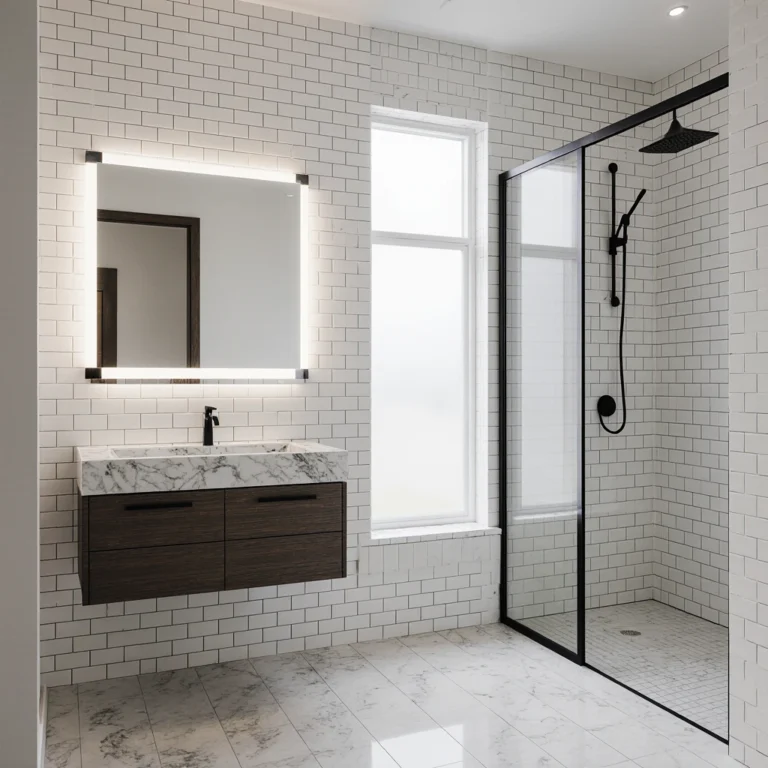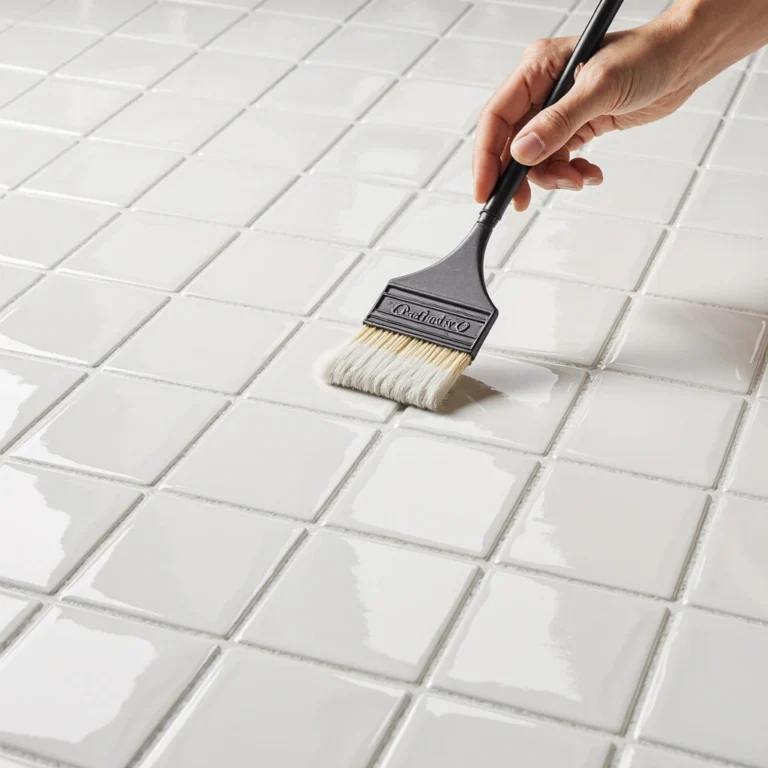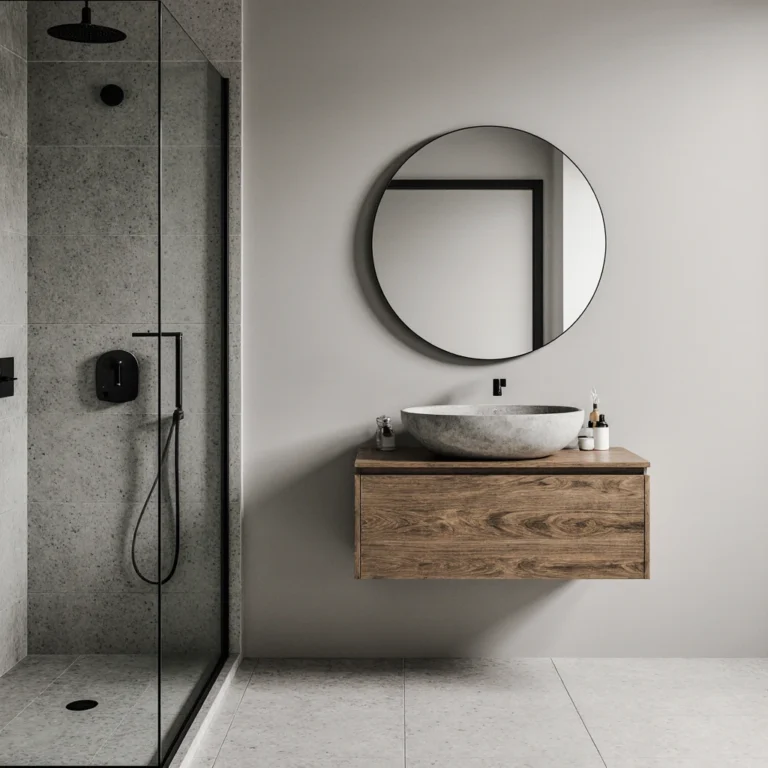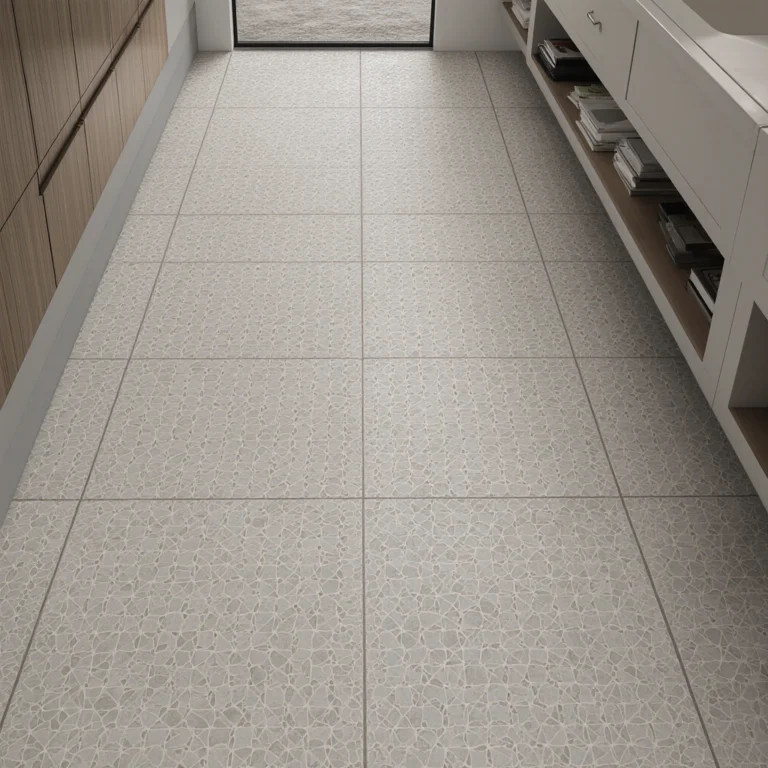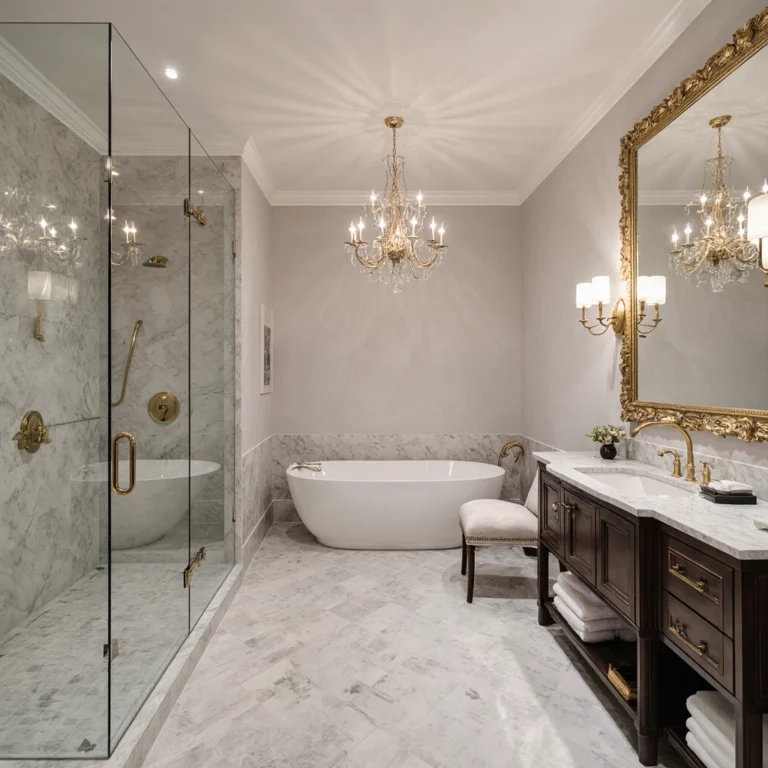Black and White Bathroom Designs: The Ultimate Guide to Timeless Elegance
Table of Contents
Black and white bathroom designs have emerged as a symbol of sophisticated elegance in modern home design. This classic color combination creates a striking visual impact while maintaining a timeless appeal. Whether you’re renovating a guest bathroom or designing a master suite, understanding the principles of monochromatic design can transform your space into a stunning sanctuary.
The beauty of black and white bathrooms lies in their versatility and timeless appeal. Recent design trends show that 68% of homeowners prefer neutral color schemes for their bathrooms, with black and white being the most popular color combination. This preference stems from their ability to create bold accents and a calming retreat, depending on how the two contrasting colors are balanced.
Why are black and white bathroom designs a great choice?
The magic of black and white bathroom designs lies in their underlying design principles. These contrasting colors create visual depth, making spaces feel larger and more dynamic. High contrast enhances architectural features, making even the simplest combinations appear more sophisticated.
From a psychological perspective, the combination of black and white promotes feelings of cleanliness, order, and calm. Black adds a touch of sophistication and appeal, while white creates brightness and spaciousness. Together, they create a balanced environment that feels luxurious and serene.
The practical benefits are equally important. Black and white designs are extremely forgiving when it comes to maintenance and updating. Unlike trendy colors that can look dated after a few years, this classic combination remains relevant for decades. Additionally, the neutral color palette allows you to add pops of color through accessories, artwork, or plants without overwhelming the space.
Bathroom Design Options for Different Sizes
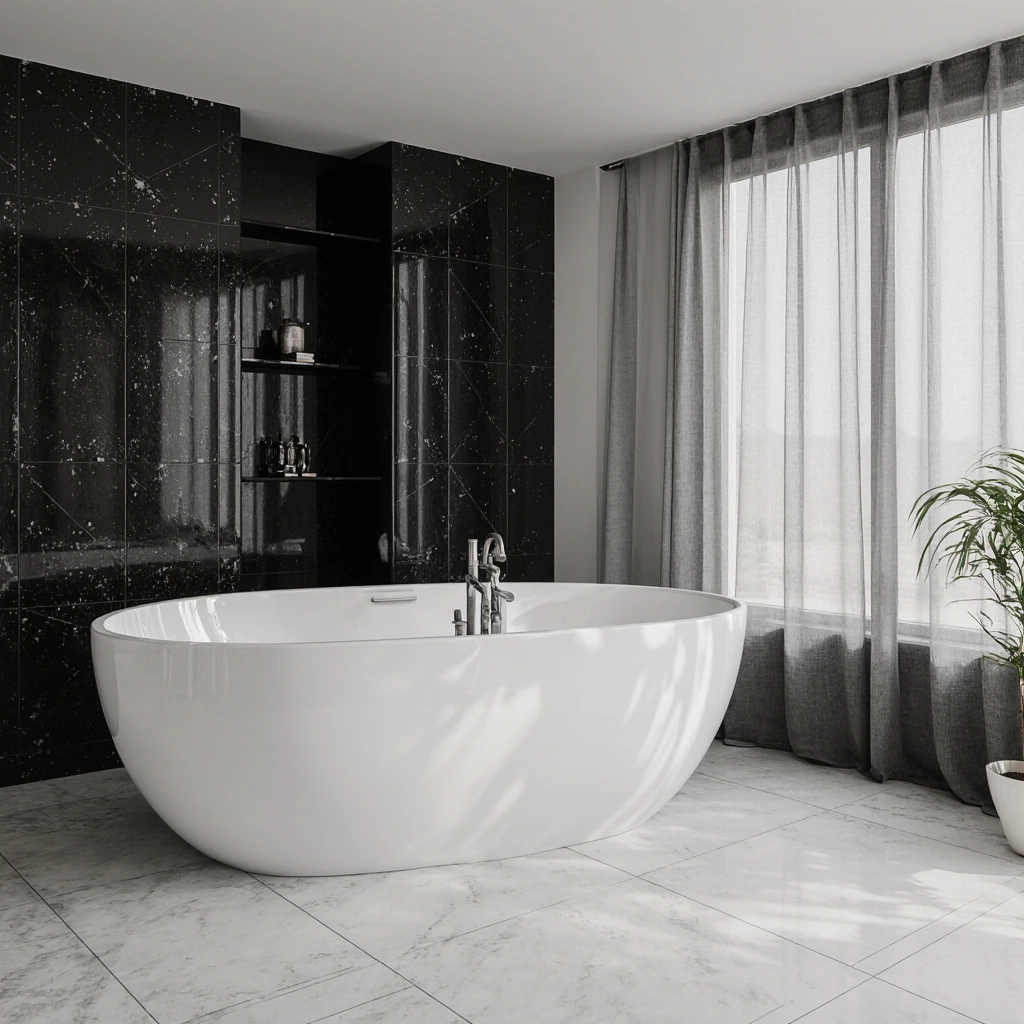
Small Bathroom Designs
Small bathrooms benefit greatly from a controlled black and white design. The secret is to use white as the main color to increase the perceived space while incorporating black as an accent color to add depth and interest.
Effective Strategies for Small Bathrooms:
- Use white or light gray tiles for walls and floors to reflect light.
- Install black fixtures such as faucets, shower heads, and metal hardware to create contrast.
- Incorporate vertical black lines across tile patterns to create the illusion of height.
- Choose a black vanity with white countertops to anchor the space.
- Add black-framed mirrors to define boundaries without overwhelming the space.
Space-Maximizing Techniques:
Consider installing a corner sink with black fixtures to save floor space. Wall-mounted toilets with black metal hardware create a sleek, modern look while also making the room appear larger. White “Sabai” tiles with black grout lines add a touch of elegance without overwhelming the space.
Large Bathroom Designs
Spacious bathrooms offer more flexibility for black and white bathroom designs. You can choose bolder colors and add more intricate patterns and textures.
Luxurious Design Ideas:
- Design a feature wall with black marble or tiles behind the vanity.
- Install a freestanding black bathtub as a centerpiece.
- Use geometric black and white floor tiles to define different areas.
- Add a black feature wall to add warmth and intimacy.
- Design separate sinks for men and women with alternating black and white elements.
Zoning Strategies:
Large bathrooms benefit from creating separate zones for different purposes. Use black elements to define the bathing area, while keeping the vanity area predominantly white for daily grooming. This approach creates visual interest while maintaining functionality.
Smart Storage Solutions for Black and White Bathrooms
Storage is a key element of any bathroom design, but black and white designs offer unique opportunities to make storage both functional and beautiful.
Integrated Storage Ideas
Enhance Your Vanity Storage:
Choose sinks in colors that contrast with your wall scheme. A white vanity against black walls creates a great contrast and provides essential storage space. Black vanity tables against white walls also add a sophisticated, minimalist touch.
Built-in Solutions:
- Install recessed shelves with black frames in white walls.
- Create floor-to-ceiling storage columns in alternating colors.
- Use black racks with white floating shelves for a modern touch.
- Add hidden storage spaces behind black-framed mirrors.
Decorative Storage Items
Stylish Organization Tools:
- Black and white striped storage baskets for towels and toiletries.
- Geometric containers in monochromatic patterns.
- Black wall-mounted shelves with white storage bins.
- Vintage-inspired black metal organizers for a timeless touch.
These storage solutions maintain the aesthetics of the design while providing practical organization. The key is to choose pieces that complement your black and white bathroom decor, not compete with it.
Materials and Finishes: Durability and Elegance
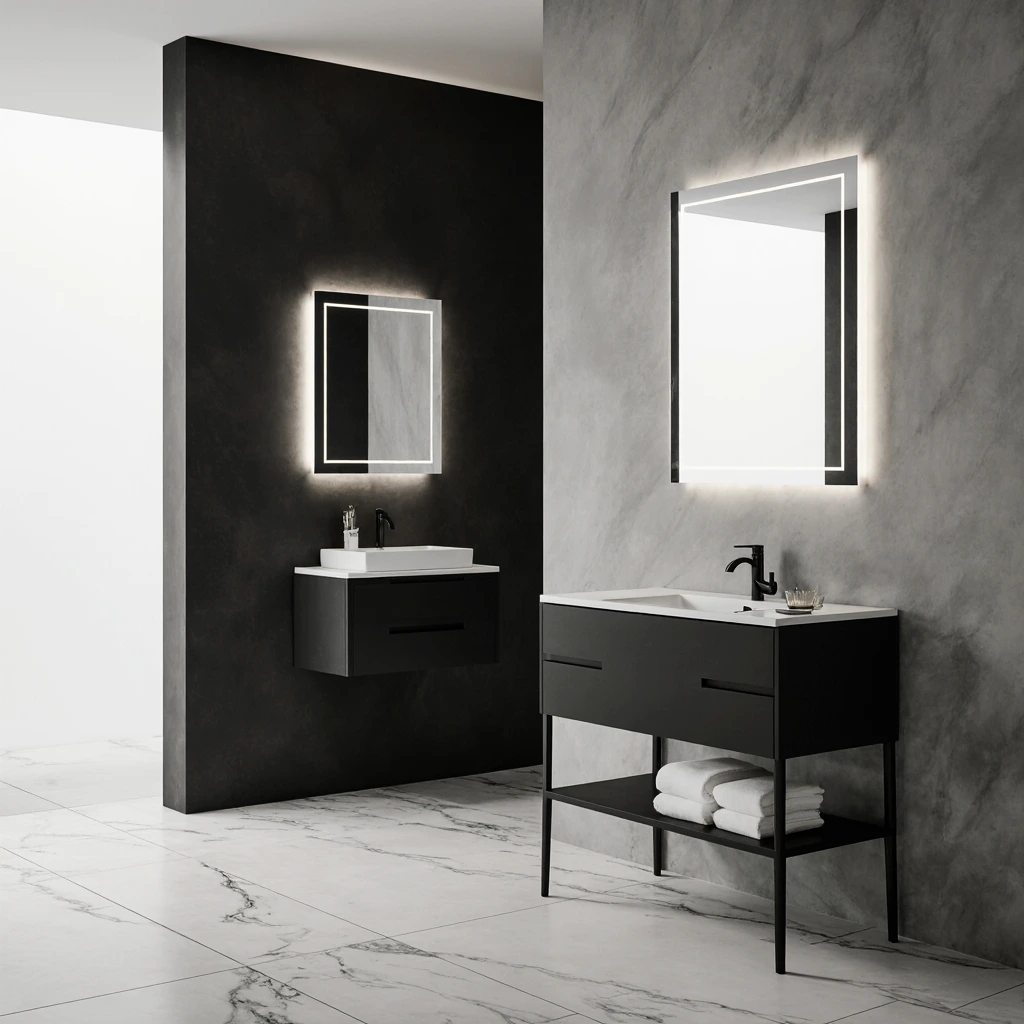
The success of black and white bathroom designs depends largely on the choice of materials. The right materials ensure longevity while maintaining the sophisticated look you’re looking for.
Tile Options
Ceramic and Porcelain Options:
High-quality black and white ceramic tiles offer excellent durability and water resistance. Choose large-format white tiles with black grout for a modern look, or classic white subway tiles with contrasting black borders for a timeless look.
Natural Stone Options:
Marble remains the gold standard for luxury bathrooms. Carrara marble with black veining adds a dramatic visual effect, while black granite countertops offer durability and elegance. For options that fit your budget, look for engineered stones that mimic natural materials.
Innovative Materials:
- Hexagonal tiles with alternating black and white patterns
- Concrete tiles with geometric designs in black and white
- Glass tiles that reflect light while maintaining the color scheme
- Luxury vinyl planks with black and white wood patterns
Fixture Finishes
Metallic Finishes:
Matte black fixtures are becoming increasingly popular, giving them a modern, industrial feel. Chrome remains classic and complements black and white elements. Brushed nickel offers a softer contrast that suits transitional designs.
Hardware Considerations:
Consistency in hardware finishes is crucial. If you choose black faucets, be sure to extend this to cabinet handles, towel bars, and light fixtures. This harmonious approach enhances the overall effect of the design.
Lighting and Ventilation Strategies
Proper lighting and ventilation are essential for any bathroom, but they are especially important in black and white designs where contrast and overall atmosphere are key.
Lighting Design Principles
A Multi-Layered Lighting Approach:
Successful bathroom lighting combines ambient, task, and accent lighting. In black and white bathrooms, this becomes crucial to prevent the space from feeling too dark or gloomy.
Ambient Lighting Solutions:
- Recessed ceiling lights provide general illumination.
- Pendant lights with black shades create distinctive focal points.
- LED strips under cabinets provide soft lighting without overwhelming the light.
- Ceiling recesses enhance natural light in appropriate areas.
Task Lighting Essentials:
- Vanity lighting should provide even illumination for cosmetics.
- Black-framed mirrors with built-in lighting combine functionality and style.
- Side sconces eliminate shadows better than overhead lights.
- Adjustable track lighting allows for flexible lighting angles.
Ventilation Solutions
Mechanical Ventilation:
Proper exhaust fans are essential to prevent moisture damage and maintain air quality. Choose models with black or white frames to complement your design.
Natural Ventilation:
Windows provide ventilation and natural light. Consider insulated glass or window blinds that complement your black and white design while maintaining its functionality.
Common Design Mistakes and Their Solutions
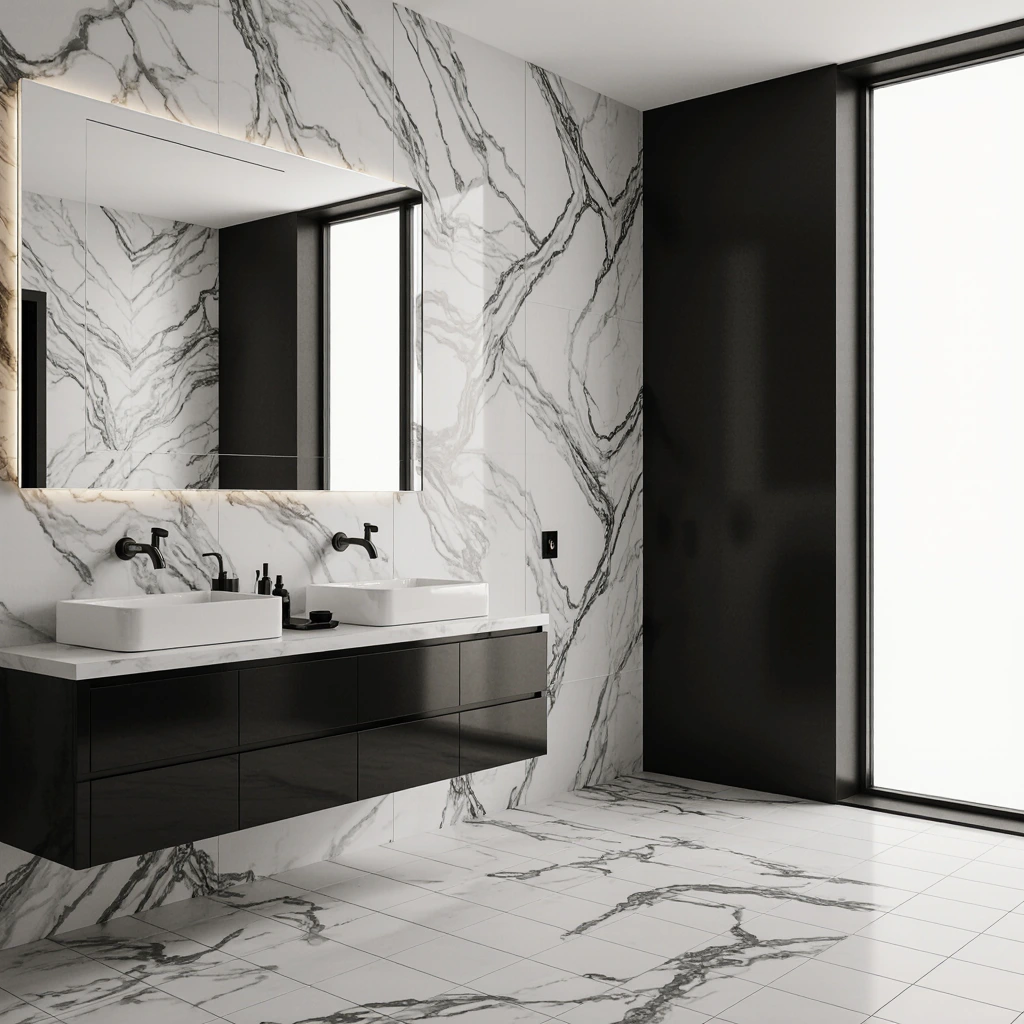
Even experienced designers can make mistakes when working on black and white bathroom designs. Understanding these common mistakes can help you avoid costly mistakes.
Balance and Proportion Issues
Mistake: Overusing Black
Black can overpower a space if used excessively. A general rule of thumb is to use black as an accent color, typically making up 20-30% of the overall color scheme.
Solution: Use the 60-30-10 rule, where white dominates 60% of the space, black provides contrast for 30%, and a third neutral color (such as gray) fills the remaining 10%.
Mistake: Neglecting Texture and Pattern
Flat black and white surfaces can look dull and unattractive without adding a touch of beauty.
Solution: Incorporate a variety of textures through materials such as natural stone, wood accents, or decorative tiles. Patterns such as geometric designs or fine lines add interest without disrupting the color scheme.
Lighting and Contrast Issues
Mistake: Inadequate Lighting Planning
Black absorbs light, making poorly lit bathrooms appear dark and uninviting.
Solution: Plan for multiple light sources and consider the color temperature of your lights. Warm white (2700-3000 Kelvin) creates a warm atmosphere, while cool white (3500-4100 Kelvin) provides better lighting for tasks.
Maintenance Considerations
Mistake: Ignoring Maintenance Requirements
Water spots and soap scum show up more easily on black surfaces than on white ones.
Solution: Choose materials appropriate for each space. Use white or light-colored tiles in shower areas where water splashes are common, and reserve black for less-used areas like feature walls.
Design Variations and Trends
Black and white bathroom designs can be adapted to various design styles, each offering unique interpretations of this classic color combination.
Modern Minimalist Style
This style is characterized by clean lines, geometric shapes, and simple motifs. Think floating bathtubs, wall-mounted toilets, and sleek fixtures in matte black.
Classic Traditional Style
Traditional black and white bathrooms feature ornate details, classic fixtures, and timeless patterns like checkerboard flooring or subway tiles with black borders.
Industrial Chic Style
Exposed fixtures, concrete elements, and metallic accents create a modern loft feel. Black iron fixtures and white subway tiles are key elements of this style.
Transitional Elegance
This design blends modern and traditional elements, offering the best of both worlds with high-end materials and meticulous detailing.
Budget-Friendly Implementation Tips
Designing stunning black and white bathrooms doesn’t require a complete renovation. Strategic updates transform your space at a reasonable cost.
High-Impact, Low-Cost Changes
Paint Change:
A fresh coat of black or white paint can dramatically change the look of your bathroom. Consider painting the cabinets or walls or creating a feature wall.
Hardware Updates:
Replacing cabinet handles, faucets, and light fixtures with black or white alternatives adds instant style without requiring a major renovation.
Tile Alternatives:
Peel-and-stick black and white patterned tiles offer a temporary solution for renters or those on a budget.
Prioritizing Renovations
Focus on Focal Points:
Invest in high-quality materials for the most important areas, such as the sink or bathtub.
A Phased Renovation Approach:
Divide the renovation process into phases, focusing on one area at a time to spread costs over the long term while maintaining functionality.
Maintenance and Longevity
Maintaining the original appearance of black and white bathroom designs requires understanding the unique challenges of each color.
Cleaning Strategies
Maintaining White Surfaces:
White surfaces show dirt and dust more easily, but are easier to clean. Regular cleaning with mild detergents maintains their lustrous appearance.
Caring for Black Surfaces:
Black surfaces hide dirt but show water spots and soap scum. Use appropriate detergents and dry surfaces after use to maintain their sleek appearance.
Long-Term Durability
Impact of Material Selection:
Choose materials appropriate for the bathroom conditions. Porcelain tiles, quartz countertops, and high-quality fixtures ensure years of reliable service.
Preventive Maintenance:
Regularly shutting off drains, maintaining good ventilation, and promptly repairing minor faults can help prevent major problems and prolong the life of your bathroom.
Conclusion: Designing Your Perfect Black and White Bathroom
Black and white bathroom designs offer unparalleled versatility, timeless appeal, and sophisticated elegance. Whether you’re working on a small bathroom or a spacious master suite, the principles outlined in this guide form the foundation for creating a stunning space that combines functionality and style.
The secret to success lies in careful planning, careful material selection, and attention to balance. Remember, black and white bathrooms are more than just color; they add contrast, depth, and visual appeal while maintaining the practical requirements of a functional bathroom.
By avoiding common mistakes, implementing smart storage solutions, and choosing the right materials and finishes, you can create a bathroom that meets your needs and inspires you daily. Investing in high-quality materials and thoughtful design will pay off for your satisfaction and the value of your home.
Are you ready to renovate your bathroom with the timeless elegance of black and white design? Start with a clear vision, prioritize your needs, and don’t hesitate to consult with specialists for complex installations. Your dream bathroom is within your grasp with the right planning and execution.
What’s the biggest challenge you face in designing your black and white bathroom? Share your thoughts in the comments below, and don’t forget to subscribe for more design inspiration and practical tips!
Best Amazon Picks :
FAQs
Q: Are black and white bathrooms difficult to maintain?
A: Black and white bathrooms require different maintenance methods for each color. White surfaces show dirt more easily, but are easy to clean with regular bathroom cleaners. Black surfaces hide dirt but show water spots and soap scum more easily. The key is to use the right cleaning products and adhere to a regular maintenance routine. Overall, the maintenance challenge is similar to any bathroom design when you understand the specific requirements of each surface.
Q: Will a black and white bathroom look outdated in a few years?
A: The black and white combination is a timeless classic in interior design. Unlike trendy colors that can quickly look outdated, this monochromatic style has remained popular for decades. This style can be refreshed with accessories, lighting, and fixture updates without the need for major renovations. Historical evidence suggests that black and white bathrooms have been consistently popular since the early 20th century.
Q: How can I add warmth to a black and white bathroom without changing the color scheme?
A: Warmth comes from texture, lighting, and materials, not color. Consider incorporating natural wood vanities, woven baskets, plants, or warm-colored lighting. Patterned tiles, natural stone, and various surface finishes add visual interest and… a distinctive touch. Touches of brass or gold add warmth while maintaining elegance. The key is to vary textures and materials within a monochromatic color palette.
Q: What is the best ratio of black to white in bathroom design?
A: The most successful black and white bathrooms typically use white as the dominant color (60-70%), with black as the accent color (20-30%), and neutral grays filling the rest. This adds a touch of beauty without overwhelming the space. In small bathrooms, it’s recommended to increase the proportion of white to increase the perceived space. Larger bathrooms allow more space for black to create a distinctive effect.
Q: Can I use a black and white design in a bathroom without natural light?
A: Absolutely! Black and white designs work well in windowless bathrooms with adequate artificial lighting. Focus on layered lighting with ambient, functional, and accent lighting. Use predominantly white surfaces to reflect light, and strategically place black elements for contrast. LED strips, recessed lighting, and well-placed mirrors create a bright and welcoming environment even in the absence of natural light.
Q: What flooring is best for a black and white bathroom?
A: There are several flooring options that work well in a black and white bathroom. Large-format white tiles with black grout create a contemporary look, while classic black and white checkerboard patterns add a timeless touch. Hexagonal tiles in alternating colors add a distinctive geometric touch. For added warmth, white tiles with black wood accents or natural stone with black veining are recommended. Make sure all flooring options are appropriate for the bathroom’s humidity levels.
Q: How do I choose between matte and glossy finishes in a black and white bathroom?
A: The choice between matte and glossy finishes depends on your taste and maintenance requirements. Glossy finishes reflect more light, making spaces appear larger and brighter, but they show water spots and fingerprints more easily. Matte finishes create a modern, sophisticated look and hide imperfections better, but they can be harder to clean. Many successful designs combine both: glossy finishes
